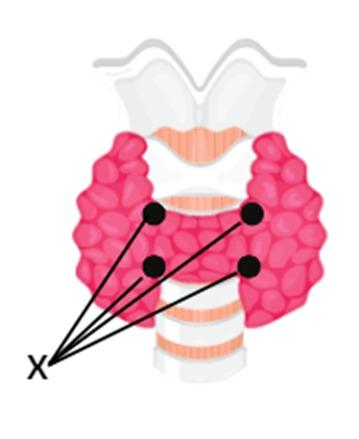
The hormone released by X marked in the given figure helps to restore Y. Identify X and Y.

X Y A. Thyroxine Too much calcium in blood B. PTH Lowered level of calcium in blood C. Thymosin Decreased level of blood sugar D. Adrenaline Excessive loss of Sodium in extracellular fluid

| X | Y |
| A. Thyroxine | Too much calcium in blood |
| B. PTH | Lowered level of calcium in blood |
| C. Thymosin | Decreased level of blood sugar |
| D. Adrenaline | Excessive loss of Sodium in extracellular fluid |
Answer
318k+ views
Hint: As the label X releases a hormone, it must be a gland. So we need to identify the gland by looking at its location. We can identify Y from the functions of X.
Complete Step by Step Answer:
According to the question, the indicated structure must be a gland as it releases a hormone, and the lack of duct in the figure suggests that it is an endocrine gland.
Now that we know the nature of the gland, let us pay attention to its location. They seem to be present in the neck region and the two lobes, which are almost butterfly-shaped, are most likely the thyroid glands. Our gland X is small in size (almost pea-sized), four in number, and two behind each thyroid gland lobes. This indicates that the X marked in the figure are parathyroid glands.
Parathyroid glands release a hormone called parathyroid hormone (PTH), also known as parathormone or parathyrin. It is a peptide hormone that plays a major role in the maintenance of blood calcium levels in our body by stimulating the osteoblasts and activation of Vitamin D.
Calcitonin helps in inhibiting the activity of osteoblasts. And hence too much calcium in the blood is restored by this hormone produced by the thyroid gland.
Insulin, secreted by the pancreas, helps in restoring decreased levels of blood sugar.
Aldosterone is secreted by the adrenal gland and restores the excessive loss of sodium in extracellular fluid.
So, the correct answer is option B.
Note: Students are most likely to confuse parathyroid glands as parts of the thyroid gland due to their small size and location. The cells of a parathyroid gland are packed relatively more densely than those in the thyroid glands. They are much smaller in size and four in number instead of two.
Complete Step by Step Answer:
According to the question, the indicated structure must be a gland as it releases a hormone, and the lack of duct in the figure suggests that it is an endocrine gland.
Now that we know the nature of the gland, let us pay attention to its location. They seem to be present in the neck region and the two lobes, which are almost butterfly-shaped, are most likely the thyroid glands. Our gland X is small in size (almost pea-sized), four in number, and two behind each thyroid gland lobes. This indicates that the X marked in the figure are parathyroid glands.
Parathyroid glands release a hormone called parathyroid hormone (PTH), also known as parathormone or parathyrin. It is a peptide hormone that plays a major role in the maintenance of blood calcium levels in our body by stimulating the osteoblasts and activation of Vitamin D.
Calcitonin helps in inhibiting the activity of osteoblasts. And hence too much calcium in the blood is restored by this hormone produced by the thyroid gland.
Insulin, secreted by the pancreas, helps in restoring decreased levels of blood sugar.
Aldosterone is secreted by the adrenal gland and restores the excessive loss of sodium in extracellular fluid.
So, the correct answer is option B.
Note: Students are most likely to confuse parathyroid glands as parts of the thyroid gland due to their small size and location. The cells of a parathyroid gland are packed relatively more densely than those in the thyroid glands. They are much smaller in size and four in number instead of two.
Recently Updated Pages
What is glandular epithelium class 11 biology NEET_UG

The common characteristics between tomato and potato class 11 biology NEET_UG

Why are manures considered better than fertilizers class 11 biology CBSE

Find the coordinates of the midpoint of the line segment class 11 maths CBSE

Distinguish between static friction limiting friction class 11 physics CBSE

The Chairman of the constituent Assembly was A Jawaharlal class 11 social science CBSE

Trending doubts
What is BLO What is the full form of BLO class 8 social science CBSE

What is meant by exothermic and endothermic reactions class 11 chemistry CBSE

Which places in India experience sunrise first and class 9 social science CBSE

What are the major means of transport Explain each class 12 social science CBSE

Which are the Top 10 Largest Countries of the World?

Fill the blanks with the suitable prepositions 1 The class 9 english CBSE




